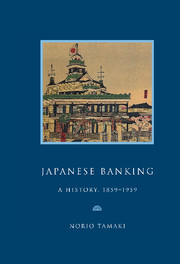Book contents
- Frontmatter
- Contents
- Preface
- Genealogy of leading Japanese banks, 1859–1959
- List of abbreviations
- Map
- Part I A bankrupt Shogunate, 1859–1868
- Part II The Meiji Restoration: monetary confusion and banking experiments, 1868–1881
- Part III Matsukata, the wizard of Japanese banking, 1881–1897; the Yokohama Specie Bank (1880) and the Bank of Japan (1882)
- Part IV The Japanese on the London money market, 1897–1911
- Part V War, the Japanese boom years, 1911–1919
- Part VI Crisis and the road to war, 1919–1937
- Historical background
- 21 Post-war collapse, 1919–1923
- 22 The 1923 catastrophic earthquake, 1927 financial disaster and the new Bank Act, 1923–1927
- 23 Financing heavy industries, 1927–1937
- 24 The challenge of militarism, and a change of roles for Nichigin and Shokin, 1929–1937
- Part VII Complete commitment, struggle and defeat, 1937–1945
- Part VIII American ‘democratisation’ and the search for growth, 1945–1959
- An extraordinary century, 1859–1959
- Appendices
- Notes
- Bibliography
- Index
Historical background
Published online by Cambridge University Press: 03 February 2010
- Frontmatter
- Contents
- Preface
- Genealogy of leading Japanese banks, 1859–1959
- List of abbreviations
- Map
- Part I A bankrupt Shogunate, 1859–1868
- Part II The Meiji Restoration: monetary confusion and banking experiments, 1868–1881
- Part III Matsukata, the wizard of Japanese banking, 1881–1897; the Yokohama Specie Bank (1880) and the Bank of Japan (1882)
- Part IV The Japanese on the London money market, 1897–1911
- Part V War, the Japanese boom years, 1911–1919
- Part VI Crisis and the road to war, 1919–1937
- Historical background
- 21 Post-war collapse, 1919–1923
- 22 The 1923 catastrophic earthquake, 1927 financial disaster and the new Bank Act, 1923–1927
- 23 Financing heavy industries, 1927–1937
- 24 The challenge of militarism, and a change of roles for Nichigin and Shokin, 1929–1937
- Part VII Complete commitment, struggle and defeat, 1937–1945
- Part VIII American ‘democratisation’ and the search for growth, 1945–1959
- An extraordinary century, 1859–1959
- Appendices
- Notes
- Bibliography
- Index
Summary
The Washington Conference of 1921–1922 which refused equal status to Japan in terms of naval power, and the abrogation of the Anglo-Japanese Alliance, which had sustained Japan from 1902, played into the hands of the small, vocal military clique in Japan which held strong anti-western fascist views. The emergence of the Union of Soviet Socialist Republics following the Russian Revolution of 1917 frightened many in Japan and weakened the already feeble socialist movement there. On the Chinese mainland, the Japanese military radicals never failed to display aggressiveness, deepening their involvement in the invasion of north-east China. Militarism gained force and the party-led government lost their ground. Of twelve prime ministers between 1920 and 1936, five were targets for assassination and three were murdered. This terrible trend was well illustrated by the two abortive military coups of 15 May 1932 and 26 February 1936 and culminated in the founding of Manchukuo in 1932 and the war against China from 1937. The isolation which the Washington Conference agreements brought about in the aftermath of the abolition of the Anglo-Japanese Alliance had far-reaching repercussions. The political and military crises were certainly exacerbated by the disaster of the Great Kanto Earthquake of 1 September 1923, which did great damage to Japan's economy and indirectly brought about the Japanese banking collapse of 1927 which preceded that on Wall Street of October 1929, which in turn resulted in world-wide recession.
- Type
- Chapter
- Information
- Japanese BankingA History, 1859–1959, pp. 139Publisher: Cambridge University PressPrint publication year: 1995



